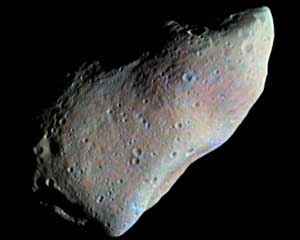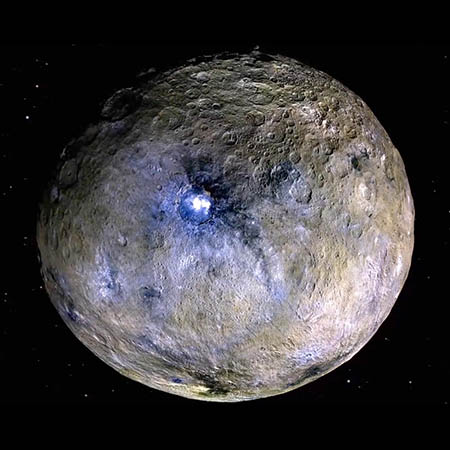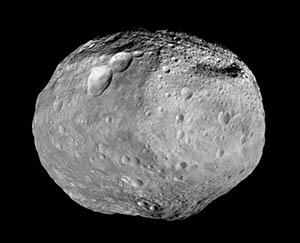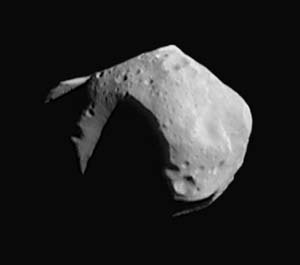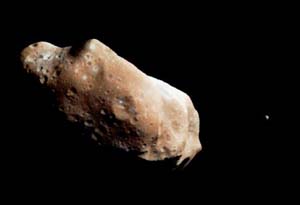Main Belt
Asteroids are metallic, rocky bodies without atmospheres that orbit the Sun but are too small to be classified as planets, so they are also known as “minor planets”.
They are in groupings in different Solar system areas and receive these names:
Near Earth Asteroids (NEAs)
Main Belt
Trojans
Centaurs*
Tens of thousands of asteroids congregate in the so-called Main Belt: a vast, doughnut-shaped ring located between the orbits of Mars and Jupiter from approximately 2 to 4 AU. Inside the belt, the asteroids concentrate on sub-groups named after the main asteroid of each one:
Hungarias, Floras, Phocaea, Koronis, Eos, Themis, Cybeles and Hildas.
Between the main concentrations of asteroids in the Main Belt are relatively empty regions known as the Kirkwood gaps. These are regions where an object's orbital period would be a simple fraction of that of Jupiter. An object in such an orbit is very likely to be accelerated by Jupiter into a different orbit.
Asteroids are thought to be primordial material prevented by Jupiter's strong gravity from accreting into a planet-sized body when the solar system was born 4.6 billion years ago. It is estimated that the total mass of all asteroids would comprise a body approximately 1,500 kilometers in diameter, less than half size of the Moon.
Known asteroids range in size from Ceres, the largest, at about 960 km in diameter down to the size of Pebbles with less of 1 Km. (See Comparative) Sixteen asteroids have diameters of 240 Km or greater. The majority of main belt asteroids follow slightly elliptical, stable orbits, revolving in the same direction as the Earth and taking from three to six years to complete a full circuit of the Sun.
Asteroids, according to their chemical composition, are classified into 3 types:
C-type (carbonaceous)
Includes more than 75 percent of known asteroids. Very dark with an albedo of 0.03 - 0.09. Composition is thought to be similar to the Sun, depleted in hydrogen, helium, and other volatiles. C-type asteroids inhabit the main belt's outer regions.
S-type (silicaceous)
Accounts for about 17 percent of known asteroids. Relatively bright with an albedo of 0.10 - 0.22. Composition is metallic iron mixed with iron- and magnesium-silicates. S-type asteroids dominate the inner asteroid belt.
M-type (metallic)
Includes many of the rest of the known asteroids. Relatively bright with an albedo of 0.10 - 0.18. Composition is apparently dominated by metallic iron. M-type asteroids inhabit the main belt's middle region.
Meteoroids, Meteorites and Meteors
The relationship between asteroids and meteoroids is still in debate, like explain bellow, but in general it is believed that these last ones are fragments of those and they also can be fragments of comets. The periodic rains of meteors like the Orionides and Draconides, happen when the Earth goes by the orbit of a comet (see Comets). The fragment of a meteoroid that is able to cross the atmosphere and hit the Earth or any other body in the space, it is denominated Meteorite, and those that don't arrive are Meteors.
The most common meteorites, known as ordinary chondrites, are composed of small grains of rock and appear to be relatively unchanged since the solar system formed. Stony-iron meteorites, on the other hand, appear to be remnants of larger bodies that were once melted so that the heavier metals and lighter rocks separated into different layers.
A long-standing scientific debate exists over whether the most common asteroids (the S-types) are the source of ordinary chondrites. Spectral evidence so far suggests that the S-type asteroids may be geochemically processed bodies akin to the stony-irons. If S-types are unrelated to ordinary chondrites, then another parent source must be found. If the two are related, then scientists need an explanation for why they aren't spectrally similar.
| Practical correspondence of the asteroids type and the meteorites type |
|
| Asteroids | Meteorites |
| Type C (Carbonaceous) | Stony |
| Type S (Silicaceous) | Stony-iron |
| Tipo M (Metálicos) | Iron |
Main Belt objects represented in 3D models

